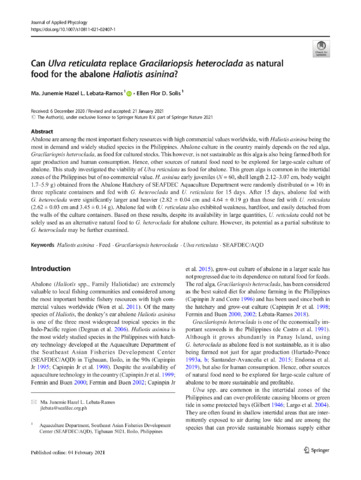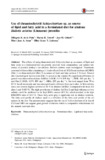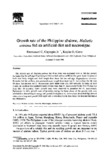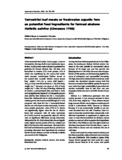Can Ulva reticulata replace Gracilariopsis heteroclada as natural food for the abalone Haliotis asinina?

View/
Request this document
Date
2021-02-04Page views
282Metadata
Show full item recordCited times in Scopus
Share
Abstract
Abalone are among the most important fishery resources with high commercial values worldwide, with Haliotis asinina being the most in demand and widely studied species in the Philippines. Abalone culture in the country mainly depends on the red alga, Gracilariopsis heteroclada, as food for cultured stocks. This however, is not sustainable as this alga is also being farmed both for agar production and human consumption. Hence, other sources of natural food need to be explored for large-scale culture of abalone. This study investigated the viability of Ulva reticulata as food for abalone. This green alga is common in the intertidal zones of the Philippines but of no commercial value. H. asinina early juveniles (N = 60, shell length 2.12–3.07 cm, body weight 1.7–5.9 g) obtained from the Abalone Hatchery of SEAFDEC Aquaculture Department were randomly distributed (n = 10) in three replicate containers and fed with G. heteroclada and U. reticulata for 15 days. After 15 days, abalone fed with G. heteroclada were significantly larger and heavier (2.82 ± 0.04 cm and 4.64 ± 0.19 g) than those fed with U. reticulata (2.62 ± 0.03 cm and 3.45 ± 0.14 g). Abalone fed with U. reticulata also exhibited weakness, hardfoot, and easily detached from the walls of the culture containers. Based on these results, despite its availability in large quantities, U. reticulata could not be solely used as an alternative natural food to G. heteroclada for abalone culture. However, its potential as a partial substitute to G. heteroclada may be further examined.
Suggested Citation
Lebata-Ramos, M. J. H., & Solis, E. F. D. (2021). Can Ulva reticulata replace Gracilariopsis heteroclada as natural food for the abalone Haliotis asinina? Journal of Applied Phycology , 33(3), 1869-1872. https://doi.org/10.1007/s10811-021-02407-1
Subject
Taxonomic term
Collections
- AQD Journal Articles [1215]
Related items
Showing items related by title, author, creator and subject.
-
Use of thraustochytrid Schizochytrium sp. as source of lipid and fatty acid in a formulated diet for abalone Haliotis asinina (Linnaeus) juveniles
de la Peña, Milagros R.; Teruel, Myrna B.; Oclarit, Jose M.; Amar, Mary Jane A.; Ledesma, Ellen Grace T. (Springer Verlag, 2016)The effects of using thraustochytrid Schizochytrium sp. as source of lipid and fatty acids in a formulated diet on growth, survival, body composition, and salinity tolerance of juvenile donkey’s ear abalone, Haliotis ... -
Growth rate of the Philippine abalone, Haliotis asinina fed an artificial diet and macroalgae
Capinpin, Emmanuel C., Jr.; Corre, Kaylin G. (Elsevier, 1996)The growth rate of Haliotis asinina fed three diets was evaluated over a 120 day period. Juveniles fed the red alga Gracilariopsis heteroclada and an artificial diet grew faster in terms of both total body weight and shell ... -
Terrestrial leaf meals or freshwater aquatic fern as potential feed ingredients for farmed abalone Haliotis asinina (Linnaeus 1758)
Reyes, Ofelia S.; Fermin, Armando C. (Blackwell Publishing, 2003)Three terrestrial leaf meals, Carica papaya, Leucaena leucocephala, Moringa oliefera and a freshwater aquatic fern, Azolla pinnata were evaluated as potential ingredients for farmed abalone diet. All diets were formulated ...





